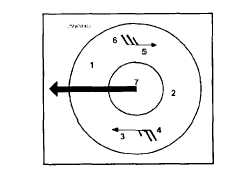2-16.
2-17.
2-18.
2-19.
Assume you a forecasting an isobar
over you station.
You find that
the current 500-hPa height over
your station is 5580-m and the
forecasted value is 5640-m.
The
current 1000- to 500-hPa thickness
is 5640-m, and the forecasted value
is 5520-m.
The current sea level
pressure is 1029.0 hPa.
What value
should you forecast for the sea
level pressure?
1.
1014.0 hPa
2.
1021.5 hPa
3.
1036.5 hPa
4.
1044.0 hPa
Which of the following processes is
capable of producing precipitation
in
1.
2.
3.
4.
appreciable
amounts.
Nonadiabatic cooling
Adiabatic lifting of air
Evaporation of additional
moisture into the air
Radiation and conduction
associated with advection
Adiabatic lifting of air can be
caused by all EXCEPT which of the
following cooling processes?
1.
Frontal lifting
2.
Orographic lifting
3.
Vertical stretching
4.
Horizontal divergence
Which of the followinq coolinq
processes is the most-effective and
intensive?
1.
Frontal lifting
2.
Orographic lifting
3.
Vertical stretching
4.
Horizontal divergence
Figure 2-A
IN ANSWERING QUESTION 2-20, REFER TO
2-20.
2-21.
2-22.
2-23.
The most marked convergence occurs
at what position?
1.
1
2.
2
3.
7
4.
4
Horizontal convergence, orographic
lifting, or frontal lifting acting
alone or in combination with one
another can occur in any particular
weather situation.
1.
True
2.
False
Which of the following processes
will NOT prevent precipitation by
increasing the temperature of the
air?
1.
Air descending the lee side of
a mountain
2.
Air descending from aloft to
compensate for divergence of
air from another region
3. Air descending because the mass
ahead of a front is moving with
a relative component away from
the front
4.
Air ascending the lee side of a
mountain
When frontal weather extends far
behind a surface cold front, the
700-hPa level isoheights will be at
what relative position?
1.
Perpendicular to the surface
front
2.
Parallel to the upper front
3.
Parallel to the surface front
4.
Perpendicular to the isotherms
2-24.
Well-developed cloud bands noted on
satellite imagery are associated
with active cold fronts at the
surface, and are the result of
which of the following processes?
1.
2.
3.
4.
The veering of the winds aloft
associated with the surface
f rent
The backing of the winds aloft
associated with the surface
front
An upper wind flow that is
nearly perpendicular to the
frontal zone
An upper wind flow that is
parallel,
or nearly parallel,
to the frontal zone
FIGURE 2-A.
11


